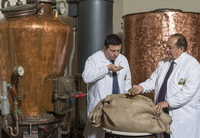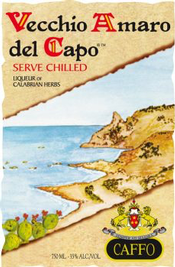|
|
 |
|
February 25, 2018
Name: Vecchio Amaro Del Capo
Producer: Distilleria Caffo
Region/Country: Calabria, Italy
Importer: Skurnik
Price: $20
Amaro (Italian for bitter) and Vermouth are similar but not quite the same. Both beverages are flavored with herbs, flowers and other botanicals, but  Vermouths are wine-based, whereas Amari (the plural form of the word) may be made from grain-based alcohol or fruit-based brandy. Vermouths are wine-based, whereas Amari (the plural form of the word) may be made from grain-based alcohol or fruit-based brandy.
Most Vermouths and Amari are distinguished by a bitter edge, which can be either very pronounced or more subtle, depending on the specific botanicals used. That bitter component is balanced by varying degrees of sweetness, usually obtained by the addition of a sugar-based syrup.
One of the world’s most popular Amari is Vecchio Amaro Del Capo, a  stellar product from Italy’s Calabria region that has been produced by the Caffo family since 1915. Distilled from sugar beets, it is macerated for several days with 29 herbs, spices, roots, fruits and flowers. stellar product from Italy’s Calabria region that has been produced by the Caffo family since 1915. Distilled from sugar beets, it is macerated for several days with 29 herbs, spices, roots, fruits and flowers.
The resulting elixir feels broad and glossy on the palate, with an intense and complex panoply of flavors including anise, coriander, citrus, bay leaf, and floral elements, plus a wisp of mint on the finish. This amaro’s bitterness is perfectly balanced by medium-sweetness.
Serve Vecchio Amaro Del Capo iced as an aperitivo, or as a digestif. It is an excellent base for cocktails. The producer recommends always serving it thoroughly chilled, but I sometimes like it at room temperature, when it seems to mellow and shift more towards opulence and dried fruit flavors balanced by good acidity. Regarding the cocktail option, here’s a recipe to try:
Catcher in the Rye:
1 ounce Vecchio Amaro Del Capo
2 ounces rye whiskey
2 ounces ginger beer
3 splashed Angostura Bitters
1 ounce fresh lemon juice
Garnish: lemon twist
Stir all ingredients in a tumbler. Add ice and lemon twist…and enjoy!
Posted by Marguerite Thomas at 2:09 PM
|
|
February 16, 2018
When I first fell in love with wine, I was frequently tormented by conflicting desires regarding the bottles that I acquired. Cellar them or drink them?
Just as it is not possible to have one's cake and eat it too, one cannot keep a wine to build a stash while also getting to drink it to build an inventory of tasting experiences. To make things worse, there's no way to know whether you'll be catching the wine at the optimal point of maturity until you've pulled the cork. If it seems too young once opened, there's no undoing the damage of premature opening. And if it seems like you've waited too long, there's no undoing the damage of an overly delayed opening.
I know that my torment over this issue isn't just a personal peculiarity (though I do have plenty of those), because I've spoken with many consumers who ask anguished questions about the optimal time for drinking cherished bottles that sit, enshrined, in their dwellings. After years of wrestling with the issue, I now find it quite easy to advise them, and I invariably advise them to get over their reverence and just drink the damned things.
There are several reasons for this. First, I've found that many more wines suffer from being held too long than being drunk too young.
Second, winemaking has changed so much during the past two decades that few wines--even sturdy red wines--really require ageing before becoming enjoyable. Even Barolo and Barbaresco and many classified growth Bordeaux can be enjoyed shortly after release these days if decanted and paired with food that has a little dietary fat (which is a natural sensory buffer against astringent tannins). You may not catch these wines at their absolute apex of complexity by cracking them while still relatively young, but you know for sure that you won't catch them at their dried, dead nadir.
Third, you don't need to worry about drinking rather than aging wines from great vintages, because there's sure to be another great vintage somewhere almost every calendar year.
This is a new situation. For example, if you were debating in 1970 whether to drink or cellar your one bottle of 1961 Bordeaux, you had a real dilemma on your hands, because there just weren't many regions making great wine back then. There was no telling when you'd get another opportunity to replace that bottle with another of comparable quality. However, a truly revolutionary diffusion of technology and expertise over the course of the past generation has now transferred potential excellence so widely across the globe that there's no such thing as a bad year. If Bordeaux gets drenched, you can still drink what you've got and be secure in the knowledge that you can replace it with this year's Don Melchor from Chile or Vilafonté from South Africa or Catena from Argentina or Penfolds Bin 707 from Australia or Quilceda Creek from Washington.
They might not all be good in 2018, but I would bet my ass that one or more of them will be fabulous. And when I taste it, I'll tell you so that you can buy it to replace the Sacred Cow you'll wisely drink on your next special occasion.
A final reason to grip 'em and rip 'em is that even the luckiest person isn't guaranteed another day, and you can't drink your treasured wine tomorrow if you get hit by a bus today. Sure, maybe there's a heaven, and if so, it would surely be well stocked with wine. But just in case, I'm going to open a really good bottle tonight to toast my good fortune....
Posted by Michael Franz at 5:49 PM
|
|
February 13, 2018
We can all agree that Champagne adds a bit of sparkle to Valentine’s Day. A box of chocolates will get high marks, too. So far so good, right? Until you take a bite of chocolate with a sip of Champagne. That’s when the Valentine’s mood is likely to sour.
Champagne and chocolate – a traditional combination on Valentine’s Day – simply do not mix. The sweetness of the chocolate will make even the finest Champagne taste harsh and acidic, hardly a match made in heaven. So, what to do?
First of all, if chocolates are a must, then shy away from a brut Champagne or any other sparkling brut, no matter its reputation. A sweet Italian bubbly such as Brachetto d’Acqui, a red wine that shows bright raspberry and strawberry flavors, is excellent with chocolates.
But if Champagne (or its domestic equivalent) is a must, think an elegant dining experience with food selections that actually work with Champagne.
Here are five suggestions that are sure to win hearts and tummies.
1. Lobster with drawn butter. It’s special, a real treat for ordinary folk, and it pairs nicely with the earthiness you will find in an older Champagne or sparkling wine.
2. Caviar is the quintessential food pairing with Champagne and, like lobster, for most of us it’s a rare treat, the sort of thing that will make your Valentine’s Day memorable.
3. Smoked salmon on toast points bring out the smoky, savory notes inherent in the finest Champagne.
4. Oysters on the half shell are a classic with Champagne, which plays off the briny, salty, earthiness of the oyster and cleanses the palate like no other wine can.
5. Potato chips, I kid you not, are one of the great matches with Champagne. It’s the salt. Champagne loves salt. Just try it!
And here are a couple of bubbly beauties to get you started: Moet & Chandon 2008 Grand Vintage Brut, Champagne ($65) and Domaine Carneros by Taittinger 2013 Brut, Carneros ($33).
Posted by Robert Whitley at 9:54 AM
|
|
February 2, 2018
Three powerhouse Napa Valley wineries dominates the top awards over the weekend at the 9th annual Winemaker Challenge International Wine Competition in San Diego. Winemaker Challenge is one of only two U.S. wine competitions judged exclusively by professional winemakers.
V. Sattui was named Winery of the Year for the second consecutive year by Winemaker Challenge Director Rich Cook. V. Sattui, located in the heart of the Napa Valley between Yountville and Calistoga, produced the Wine of the Year, a cabernet sauvignon from the historic Morisoli Vineyard.
The V. Sattui 2014 Cabernet Sauvignon, Morisoli Vineyard, Napa Valley ($95) earned a score of 97 points on the 100-point scale. The V. Sattui 2016 Select Late Harvest Riesling, Anderson Valley ($45) was Best Dessert Wine with a score of 96 points.
Overall, V. Sattui took a stunning 40 medals from 44 wines entered. The total included four platinum awards and 14 golds. V. Sattui is somewhat unique among high-profile Napa Valley wineries, eschewing nationwide distribution and selling its wines only at the winery or online.
V. Sattui was joined in the winners’ circle by two other stellar Napa Valley producers. The 2013 Domaine Carneros by Taittinger Brut, Carneros ($45) took Best Sparkling and the 2015 Cakebread Cellars Reserve Chardonnay, Carneros ($56) Best White, each with a score of 95 points.
The only non-Napa Valley winery to crack the top echelon of best-of-show awards was the 2017 Hart Winery Rose of Sangiovese, Temecula Valley ($23) with a score of 94 points.
Although no foreign wines made the best-of-show list either, the foreign contingent was hardly skunked. The 2016 Heirloom Vineyards Shiraz, Barossa, Australia ($40) was the highest-scoring foreign wine and the second-highest scoring red overall at the competition, with a score of 96 points.
The Bolla 2010 Le Origini Amarone della Valpolicella Classico DOC, Italy ($65) was nipping at the heels of the Aussie Shiraz with a score of 95 points.
The 1002 wines entered were most in the nine years of Winemaker Challenge. From that total only 45 wines earned a platinum award with a score of 94 points or higher. The 18 winemaker judges evaluated the wines in panels of three, with all the wines tasted “blind,” meaning the name of the producer and price of the wine were not revealed to the judges until after the results were declared official.
Posted by Robert Whitley at 3:27 PM
|
|
 |
|